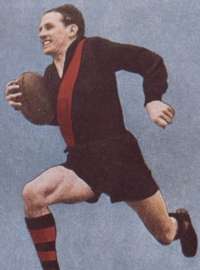Dick Reynolds
| Dick Reynolds | |||
|---|---|---|---|
 | |||
| Personal information | |||
| Full name | Richard Sylvannus Reynolds | ||
| Nickname(s) | King Richard | ||
| Date of birth | 20 June 1915 | ||
| Date of death | 2 September 2002 (aged 87) | ||
| Original team(s) | Woodlands (EDFL) | ||
| Height / weight | 179 cm / 82 kg | ||
| Playing career1 | |||
| Years | Club | Games (Goals) | |
| 1933–1951 | Essendon | 320 (442) | |
| Representative team honours | |||
| Years | Team | Games (Goals) | |
| Victoria | 19 (19) | ||
| Coaching career3 | |||
| Years | Club | Games (W–L–D) | |
| 1939–1960 | Essendon | 415 (275–134–6) | |
|
1 Playing statistics correct to the end of 1951. 3 Coaching statistics correct as of 1960. | |||
| Career highlights | |||
| |||
Richard Sylvannus "Dick" Reynolds (20 June 1915 – 2 September 2002) was an Australian rules footballer who represented Essendon in the Victorian Football League (VFL) in the 1930s and 1940s.
Reynolds is one of four footballers to have won three Brownlow Medals, the others being Haydn Bunton, Sr., Bob Skilton and Ian Stewart. Revered by Essendon supporters, he was often referred to simply as "King Richard".[1]
Early life and career
Reynolds grew up supporting Carlton and sold lollies outside Princes Park on match days.[1] He had several relatives who also became League footballers, including his brother Tom, cousin Max Oppy, and grandson Joel.
When Reynolds won his first Brownlow Medal in 1934, Fitzroy champion Haydn Bunton, Sr., whom Reynolds had narrowly beaten to win the award, was the first person to telegraph his congratulations, a sporting gesture that Reynolds deeply appreciated.[2]
In June 1947, it was announced that Reynolds would start writing about football for the now-defunct Melbourne newspaper The Argus.[3]
Like many footballers, Reynolds was also a noted cricketer. He was a successful medium-fast bowler for Essendon Cricket Club but gave up the game when it started to interfere with football.[4] In January 1949, he made a return to district cricket when Essendon batsman Ken Meuleman was picked for State duty.[4]
After being re-elected yet again as player-coach by the Essendon committee in February 1949,[5] Reynolds guided the Bombers to the Grand Final against Carlton, which they won by 73 points. Reynolds, who was playing his 299th game, described it afterwards as "the best Essendon performance he could remember."[6]
Off the field, Reynolds was a shy and private man, noted for his humility about his footballing achievements.
Later life and death
Just three days before his death, after being given a standing ovation by the crowd at the "Champions of Essendon" announcement dinner, at which he was named the greatest Essendon player of all time, Reynolds was visibly moved and stated "I don't deserve this honour... Bill Hutchison was the best player I ever saw."[7]
Reynolds' funeral was held at St Paul's Cathedral, Melbourne on 6 September 2002. After the service the hearse made its way to Windy Hill, where Essendon fans had gathered to farewell their greatest player one last time.[1]
His family's link with Essendon continued when his grandson Joel Reynolds was selected by the club in the 2001 AFL Draft. He made his debut in Round 3, 2002 against Brisbane at the Gabba, with Dick watching from the stands.
A statue in his honour was erected in 2004 at the Parade of Champions at the Melbourne Cricket Ground.[8]
References
- 1 2 3 Baum, Greg (7 September 2002). "The legacy of Essendon's greatest son". The Age.
- ↑ "It was a joy to watch Bunton play.". The Argus. Melbourne: National Library of Australia. 6 September 1955. p. 18. Retrieved 1 August 2012.
- ↑ "DICK REYNOLDS WILL WRITE FOR The Argus.". The Argus. Melbourne: National Library of Australia. 6 June 1947. p. 1. Retrieved 10 September 2013.
- 1 2 "DICK REYNOLDS BACK WITH ESSENDON CC.". The Argus. Melbourne: National Library of Australia. 20 January 1949. p. 19. Retrieved 10 September 2013.
- ↑ "DICK REYNOLDS RE-ELECTED.". The Argus. Melbourne: National Library of Australia. 23 February 1949. p. 23. Retrieved 10 September 2013.
- ↑ "REYNOLDS PLAYED 299th GAME.". The Argus. Melbourne: National Library of Australia. 27 September 1949. p. 19. Retrieved 10 September 2013.
- ↑ "Champions of Essendon Gala Dinner". essendonfc.com.au. 20 August 2002.
- ↑ King Richard reigns at MCG, Melbourne Cricket Ground, 20 June 2004.
Bibliography
- Maplestone, M. (1996). Flying Higher: History of the Essendon Football Club 1872–1996. Essendon: Essendon Football Club. ISBN 0-9591740-2-8.
- Miller, W.; Petraitis, V.; Jeremiah, V. (1997). The Great John Coleman. Cheltenham: Nivar Press. ISBN 0-646-31616-8.
- Ross, John, ed. (1996). 100 Years of Australian Football 1897–1996: The Complete Story of the AFL, All the Big Stories, All the Great Pictures, All the Champions, Every AFL Season Reported. Ringwood: Viking. ISBN 0-670-86814-0.
- Holmesby, Russell; Main, Jim (2002). The Encyclopedia of AFL Footballers: every AFL/VFL player since 1897 (4th ed.). Melbourne, Victoria: Crown Content. p. 546. ISBN 1-74095-001-1.